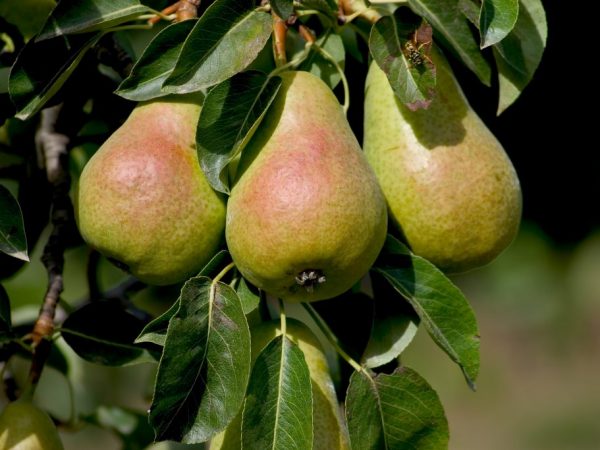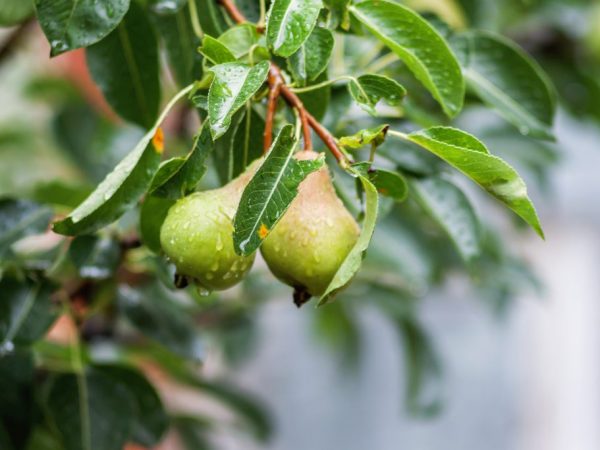Characteristics of the cathedral pear variety
Cathedral pear is a winter-hardy, early-growing variety of fruit trees. Fruits of this type are suitable for raw consumption and preservation. The crop produces good yields even under unfavorable growing conditions.

Characteristics of the cathedral pear variety
Variety characteristic
Positive qualities of the variety:
- high productivity;
- early maturity;
- disease resistance.
Despite the positive qualities, the variety has a number of disadvantages:
- small fruit size;
- second-rate fruit taste;
- short shelf life.
The species is widely used in temperate and warm climatic zones. The variety is resistant to diseases, therefore it is used for breeding. Cathedral pear needs pollinators for good yields. The variety begins to bear fruit in 3-4 years.
Description of the tree
The crown has the shape of a pyramid, the density of the deciduous cover is average. The branches are located at sharp angles to the trunk (26-31 °). The bloom is dense. The height of the tree is 3-4 m.
Leaves are elongated, with a pointed end, rich green color, with a short petiole. The plate is smooth, thick, and twisted upward.
Description of fruits
The fruits ripen in the second half of August, are tied in several pieces per inflorescence and are firmly attached to the tree. The average fruit size is from 110 to 130 g. It is well transportable. The shape is elongated, pear-shaped.
Cathedral pear usually has a dry, dense and rough skin. The fruit that grew on the sunny side is covered with crimson dots. The stalk is short, thickened on both sides.
The share of sugars in one fruit is 8.5%, acids - 0.3%.
Care
Sapling selection
Smooth and even seedlings should be chosen. It is recommended to purchase annuals, as they have a good survival rate. Before planting, the tree is kept in a bucket of water for 2-3 hours. This helps him to quickly adapt to new conditions.
How to choose a seedling:
- Inspect the seedling for pests.
- Pay attention to the uniformity of the color: it should be uniform in the branches of the seedling. The presence of spots indicates the presence of diseases of the pear.
- Buy seedlings from trusted sellers.
When planting, it is required to ensure that the size of the pit corresponds to the size of the root system. It is important that the planting stake, treated from rotting from the underside, is driven into the ground by at least half a meter. It is necessary to pour humus and peat into the pit.
Mulching
Mulch prevents the soil from overheating in summer. The procedure is best done in the spring, but before doing this it is important to make sure the soil is moist and free of weeds. The best materials are straw, hay, freshly cut grass, finely crushed nettle, sawdust. Also, special bark for mulching trees and rotted needles are suitable.
Watering

Follow your watering schedule
Pear Cathedral needs regular watering. Irrigation should be carried out strictly according to a specific schedule:
- when buds open (May);
- 10 days after flowering (June);
- during the period when the fruits are poured (early-mid July);
- when the tree begins to shed its leaves (early October).
For seedlings, 3-4 liters of water are enough. The volume of water required for adult pears is 7 buckets per tree. It is important to avoid the most common mistake: watering near the trunk. The tree should be watered under the crown.
It is necessary to ensure that the water depth near the tree is 6-8 m.
Top dressing
In the first year after planting, the Cathedral pear does not need fertilization. In the second year, the tree must be fed with organic mixtures. Top dressing should contain mineral components:
- nitrogen - 0.5%;
- potassium - 0.3%;
- phosphorus - 0.3%
Nitrogen is used only during spring feeding. During the summer, the tree prepares for wintering, and stimulating growth can harm the crop.
To increase the resistance of the tree to frost and disease, prophylactic treatment with a solution of zircon or ecoberine is carried out: this protects the trees from the larvae of harmful insects and fungus. Also, old bark and moss are cleaned from the trunk.
Crown formation
In the first year, the tree does not need pruning. In the second year, the first tier is formed. For this, only 2 strong branches are left, the rest are cut off under the ring. It is best to prune in the spring when the air temperature is at least -8 ° C. Circumcision is carried out before the start of sap flow.
It is worth cutting off damaged leaves. It is also advised to remove infected or rotten fruits. Pruning is not recommended in summer and winter. Weather conditions during these seasons will not allow the saw cut to drag out, which will significantly weaken the plant.
Pests and diseases
The garden pear variety Cathedral is resistant to diseases, but as a preventive measure, it is advisable to remove the leaves after leaf fall.
Leftover foliage can cause scab. The disease is vulnerable to Horus. Prevention is carried out before flowering.
This variety can be susceptible to leaf gall midge. This is a small insect up to 2-3 mm in size, which feeds on young leaves. Insecticides help to get rid of leaf gall midge.
There are other pests that can harm the plant:
- gall mites;
- aphid;
- moths;
- honeycorns.
Proper care helps to get rid of them. It is necessary to remove fallen leaves on time and check the condition of the tree once a week: examine the leaves, bark, branches, fruits. Whitewashing the trunk with lime serves as a good protection against pests. You should also carry out the treatment with a 3% solution of boric liquid before and after flowering.
Conclusion
The cathedral pear attracts many gardeners with its description. The variety is unpretentious in care. The crop is suitable for cultivation on private plots and on an industrial scale.

